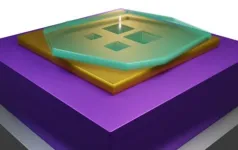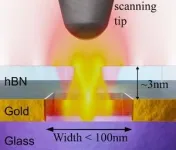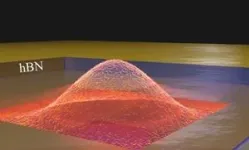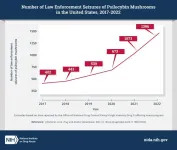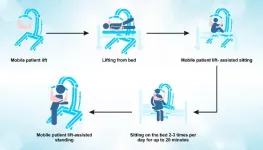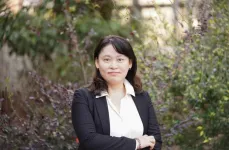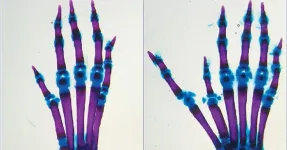Breaking boundaries in quantum photonics: Groundbreaking nanocavities unlock new frontiers in light confinement
Dr. Hanan Herzig Sheinfux, from Bar-Ilan University: “What started as a chance discovery, may well open the way to new quantum applications, pushing the boundaries of what we thought was possible.”
2024-02-06
(Press-News.org)
In a significant leap forward for quantum nanophotonics, a team of European and Israeli physicists, introduces a new type of polaritonic cavities and redefines the limits of light confinement. This pioneering work, detailed in a study published today in Nature Materials, demonstrates an unconventional method to confine photons, overcoming the traditional limitations in nanophotonics.
Physicists have long been seeking ways to force photons into increasingly small volumes. The natural length scale of the photon is the wavelength and when a photon is forced into a cavity much smaller than the wavelength, it effectively becomes more "concentrated". This concentration enhances interactions with electrons, amplifying quantum processes within the cavity. However, despite significant success in confining light into deep subwavelength volumes, the effect of dissipation (optical absorption) remains a major obstacle. Photons in nanocavities are absorbed very quickly, much faster than the wavelength, and this dissipation limits the applicability of nanocavities to some of the most exciting quantum applications.
The research group of Prof. Frank Koppens from ICFO in Barcelona, Spain, addressed this challenge by creating nanocavities with an unparalleled combination of subwavelength volume and extended lifetime. These nanocavities, measuring smaller than 100x100nm² in area and only 3nm thin, confine light for significantly longer durations. The key lies in the use of hyperbolic-phonon-polaritons, unique electromagnetic excitations occurring in the 2D material forming the cavity.
Unlike previous studies on phonon polariton-based cavities, this work utilizes a new and indirect confinement mechanism. The nanocavities are crafted by drilling nanoscale holes in a gold substrate with the extreme (2-3 nanometer) precision of a He focused ion beam microscope. After making the holes, hexagonal boron nitride (hBN), a 2D material, is transferred on top of it. The hBN supports electromagnetic excitations called hyperbolic-photon polaritons which are similar to ordinary light except that they can be confined to extremely small volumes. When the polaritons pass above the edge of the metal, they experience a strong reflection from it, which allows them to be confined. This method thus avoids shaping the hBN directly and preserves its pristine quality, enabling highly-confined AND long-lived photons in the cavity.
This discovery began with a chance observation made during a different project while using a nearfield optical microscope to scan 2D material structures. The nearfield microscope allows exciting and measuring polaritons in the mid-infrared range of the spectrum and the researchers noticed an unusually strong reflection of these polaritons from the metallic edge. This unexpected observation sparked a deeper investigation, leading to the realization of the unique confinement mechanism and its relation to nanoray formation.
However, upon making and measuring the cavities, the team were in for a huge surprise. “Experimental measurements are usually worse than theory would suggest, but in this case, we found the experiments outperformed the optimistic simplified theoretical predictions,” said first author, Dr. Hanan Herzig Sheinfux, from Bar-Ilan University’s Department of Physics. “This unexpected success opens doors to novel applications and advancements in quantum photonics, pushing the boundaries of what we thought was possible.”
Dr. Herzig Sheinfux conducted the research with Prof. Koppens during his postdoctoral term at ICFO. He intends to use these cavities to see quantum effects that were previously thought impossible, as well as to further study the intriguing and counterintuitive physics of hyperbolic phonon polariton behavior.
END
ELSE PRESS RELEASES FROM THIS DATE:
2024-02-06
Promising trial results indicate that a new type of cell therapy could improve the prognosis of those who are critically ill with acute respiratory distress syndrome (ARDS) resulting from severe Covid-19.
Published in the journal Nature Communications, Professor Justin Stebbing of Anglia Ruskin University (ARU) is the joint senior author of the new study investigating the use of agenT-797, MiNK Therapeutic’s allogeneic, unmodified invariant natural killer T (iNKT) cell therapy.
The iNKT cell therapy has the effect of rescuing exhausted T cells and prompting an anti-inflammatory cytokine response, potentially activating anti-viral immunity to ...
2024-02-06
Law enforcement seizures of “magic mushrooms” or “shrooms” containing the psychoactive component psilocybin increased dramatically in the United States between January 2017 and December 2022, according to a new study funded by the National Institute on Drug Abuse, part of the National Institutes of Health. The number of law enforcement seizures increased from 402 seizures in 2017 to 1,396 in 2022. In addition, the total weight of psilocybin mushrooms seized by law enforcement increased ...
2024-02-06
Seizures by law enforcement officials of psilocybin, a compound found in psychedelic mushrooms, have increased by 369% since 2017, a new study shows. The authors say their findings may signal growing availability and public awareness of the hallucinogenic drug, along with possible heightened risks associated with recreational and unsupervised use of the drug.
The study was led by researchers at NYU Grossman School of Medicine and other members of the National Drug Early Warning System, an organization that conducts surveillance of shifting drug trends. Their analysis of national and state-level trafficking data ...
2024-02-06
Decidious and evergreen forests dominate the limestone karst formations of the northwestern highlands of Thailand. A vast number of caves and rock shelters intersperses the mountains. In over 40 such caves in Mae Hong Son province, large wooden coffins mounted on stilts, dating between 2,300 and 1,000 years ago, can be found. During the Iron Age period, each of these up to several-meter-long coffins was crafted from a single teak tree and features refined carvings of geometric, animal- or human-like shapes at the handles ...
2024-02-06
Tokyo, Japan – A recent randomized controlled trial in Tokyo, Japan, has unveiled the positive impact of early mobilization, assisted by mobile patient lifts, on the recovery of ventilated intensive care unit (ICU) patients. The debate surrounding the efficacy of early mobilization in ICU has persisted for an extended period.
The treatment of critically ill patients in ICUs, often involving prolonged limb immobilization or restricted mobility, is acknowledged as a risk factor for diminished physical strength and diminished quality of life post-recovery, ...
2024-02-06
Rates of re-excision after initial breast-conserving surgery in women with breast cancer remain high across the United States, leading to an increased cost of care and a higher risk of postoperative complications, according to new research from UTHealth Houston.
The study, led by first author Youngran Kim, PhD, assistant professor; and senior author Trudy Krause, PhD, professor, was published today in Annals of Surgical Oncology. Both are with the Center for Health Care Data in the Department of Management, Policy ...
2024-02-06
Our genomes provide the instructions for proper growth and development. Millions of genomic switches, known as enhancers, control the location and timing of gene expression, which in turn ensures the correct proteins are made in the right cells at the right time throughout our lives. New research from University of California San Diego Assistant Professor Emma Farley’s lab shows how we can now predict which single base-pair changes to the DNA within our genomes will alter these instructions and disrupt development, causing extra digits and hearts.
We now ...
2024-02-06
One of the most common add-ons to IVF procedures undertaken in Australia and globally by infertile couples may be a waste of time as well as expensive and invasive, and maye even reduce the chances of success, according to a new report in The Lancet.
The research, by Monash University’s Professor Ben Mol in Australiaa and Dr. Rui Wang and colleagues in China, found that intracytoplasmic sperm injection (ICSI) whereby a single sperm is injected directly into a mature egg – originally developed in 1992 for couples with severe male infertility but which has since expanded ...
2024-02-06
Males born to obese women are more likely to be overweight at birth and develop metabolic complications in later life, including liver disease and diabetes.
The way that male sex hormones activate pathways in the developing liver is partly to blame.
That’s the finding from a new study led by University of South Australia (UniSA) researchers looking at the impact of maternal obesity on fetal liver androgen signalling.
Male fetuses of obese pregnant women have different signals that are activated by male sex hormones in the liver, which encourages them to prioritise growth at the expense of their health.
UniSA researcher Dr Ashley Meakin ...
2024-02-06
Understanding the responses of different rhizosphere microbial lineages to soil amendments during in situ remediation of Cd-contaminated soil is of great importance in the assessment of the restoration and crop health. This study demonstrates the distinct responses of rice rhizosphere microbial communities to soil amendment applications, highlighting the interactive associations between microbiomes, which is vital for enhancing our ability to develop effective strategies for sustainable soil management. The researchers' findings appeared December 4, 2023 in Soil Ecology Letters.
A series ...
LAST 30 PRESS RELEASES:
[Press-News.org] Breaking boundaries in quantum photonics: Groundbreaking nanocavities unlock new frontiers in light confinement
Dr. Hanan Herzig Sheinfux, from Bar-Ilan University: “What started as a chance discovery, may well open the way to new quantum applications, pushing the boundaries of what we thought was possible.”
